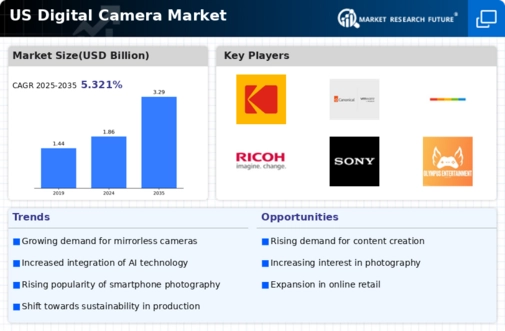The US Digital Camera Market has evolved significantly, characterized by rapid technological advancements and shifting consumer preferences. As digital photography becomes increasingly popular, various brands vie for market share by introducing innovative products that cater to diverse needs, from amateur photographers to professional users. Competitive dynamics are influenced by factors such as product quality, brand reputation, pricing strategies, and marketing efforts. Companies in this sector continually adapt to trends in mobile photography, social media, and consumer electronics, impacting their market strategies.
Understanding these competitive insights is crucial for businesses looking to establish themselves or expand their presence in this vibrant market landscape. Kodak remains a significant player in the US Digital Camera Market, leveraging its long-standing legacy and brand recognition.
The company's strengths lie in its ability to blend nostalgic appeal with modern technology, offering products that reflect both traditional photographic principles and contemporary digital capabilities. Kodak's strategic focus on user-friendly cameras, particularly in the affordable segment, has resonated well with entry-level consumers and hobbyists. Their commitment to innovation, along with a robust marketing approach, allows them to maintain a competitive edge. Additionally, Kodak's historical significance in the photography realm lends it a unique position, appealing to consumers seeking authenticity and reliability in their camera choices.
Canon is another formidable presence in the US Digital Camera Market, known for its comprehensive range of high-quality imaging products, including DSLR and mirrorless cameras, as well as point-and-shoot models.
The company's strengths are highlighted by its cutting-edge technology, superior lens systems, and a well-established ecosystem that includes accessories and software solutions tailored for photographers. Canon has successfully captured both professional and amateur user segments, bolstered by its commitment to continuous research and development. Mergers and acquisitions have played a strategic role in Canon's growth, enabling the company to diversify its offerings and bolster its market position. With a strong focus on customer engagement and support, Canon excels in brand loyalty, making it a key competitor in the highly competitive US digital camera space.















